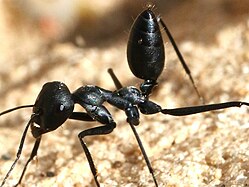Gaster (insect anatomy)

The gaster is the bulbous posterior portion of the metasoma found in hymenopterans of the suborder Apocrita (bees, wasps and ants). This begins with abdominal segment III on most ants, but some make a constricted postpetiole out of segment III, in which case the gaster begins with abdominal segment IV.[1][2]
The gaster in ants contains what is sometimes called the "social stomach," which is named for the fact that food can be carried within it and then shared with other members of the colony.[3]
Certain ants in the genus Cataglyphis, including Cataglyphis bicolor and Cataglyphis fortis, have a cubiform petiole that allows them to decrease their inertia (and therefore increase their speed) by raising their gaster into an upright position.[4]
Parasitism
[edit]In ants, the gaster is the site for certain endoparasites including several species of the nematode families mermithidae and tetradonematidae. Certain mermithidaen that inhabit ant hosts only inhabit a single species or genus while others also target insects other than ants. These endoparasites have been parasitizing ants for 20-30 million years, as seen in amber from the Dominican Republic. Infection by a mermithidean nematode is evidenced by a swelling of the gaster at the young nematode developes. Eventually the endoparasite forces its host to water where it then exits, killing its host. Only two tetradonematidae nematodes have been noted to use ants as a host. These endoparasites spend their entire life cycle within a host. Myrmeconema neotropicum is particularly notable for altering the color of their host's gaster to be bright red.[5]
-
Cataglyphis nigra with raised gaster
References
[edit]- ^ "Ant Information". Insected.arizona.edu. Archived from the original on 2014-10-07. Retrieved 2014-08-20.
- ^ "Notes from Underground-members". Desertants.org. Archived from the original on 2013-05-17. Retrieved 2014-08-20.
- ^ Bouisset, Guillaume; Merienne, Hugo; Fourcassié, Vincent (2024). "Walking kinematics of ants carrying food in the mandibles versus gaster". Journal of Experimental Biology.
- ^ McMeeking, Robert M .; Arzt, Eduard; Wehner, Rüdiger (July 2011). "Cataglyphis desert ants improve their mobility by raising the gaster". Journal of Theoretical Biology. 297: 17–25. doi:10.1016/j.jtbi.2011.12.003. PMID 22178639.
- ^ Poinar, George, Nematode Parasites and Associates of Ants: Past and Present, Psyche: A Journal of Entomology, 2012, 192017, 13 pages, 2012. https://doi.org/10.1155/2012/192017

